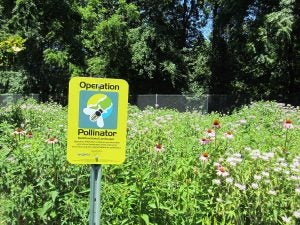From the White House to General Mills, everyone is buzzing over National Pollinator Week. But there’s more to the week than building up the bee population, it’s also an important time to showcase the direct benefit farmers receive from building habitats.
“Agricultural landscapes can provide essential foraging and nesting habitats for pollinators,” said Syngenta’s pollinator health lead, Caydee Savinelli. “With the right management, designated crop margin areas can provide an ideal habitat for a vast array of pollinating insects and can potentially improve farmers’ yield, crop quality, and profitability.”
Operation Pollinator is a global initiative created by Syngenta that aims to restore pollinator populations in agricultural and golf course landscapes by working to create essential habitats and forage. Supported by AgriEdge Excelsior, the program gives farmers the resources, tools, and skills to successfully and cost-effectively establish and manage attractive wildflower resources crucial for honey bees, native bees, and other pollinating insects such as monarch butterflies. Guidelines and recommendations were developed specifically for agricultural landscapes in conjunction with university researchers and agronomists.
“One important distinction to make is that Syngenta does more than provide the wildflower seed needed to cultivate these habitats,” Savinelli said. “We also advise on site selection and the agronomics of maintaining a successful habitat.”
A boots-on-the-ground approach, Operation Pollinator has collaborated with commercial farmers, such as major potato producer R.D. Offutt, to convert unused farmland to habitats.
Syngenta agronomists have also planted Operation Pollinator plots at many of the company’s Grow More Experience sites throughout the country to help communicate to farmers and resellers that habitats and farmland can co-exist.
“Boosting pollinator populations is a clear benefit farmers can achieve with effective wildflower plant management,” Savinelli said. ”Results from Operation Pollinator show native pollinators and honey bees respond positively when regionally adapted native wildflower mixes are planted.”

In addition to demos, Operation Pollinator has also sponsored university research in three key areas of the United States to evaluate flower seed mixes, including annuals, perennials, and insects that visited the sites. The research demonstrated the benefits of having multiple plant species and showed the diversity and timing of pollinators visiting the sites.
Operation Pollinator goes beyond farmland and golf courses. Through the AgriEdge program, Syngenta has collaborated with NGOs to develop forage and habitat sites such as The Bee & Butterfly Habitat Fund, Project Apis m., Trees Forever, and Delta F.A.R.M.
For farmers considering starting their own habitat, Syngenta offers several tips and additional resource guides on their web site.
“Managing farm areas specifically for pollinator habitats significantly increases biodiversity and brings about real environmental benefits, leaving growers to continue farming efficiently and profitably on the most productive parts of the field,” Savinelli said. “Through Operation Pollinator, farmers and the agribusiness community will see firsthand how sustainable agriculture and science-based solutions can work together to preserve the environment.”



